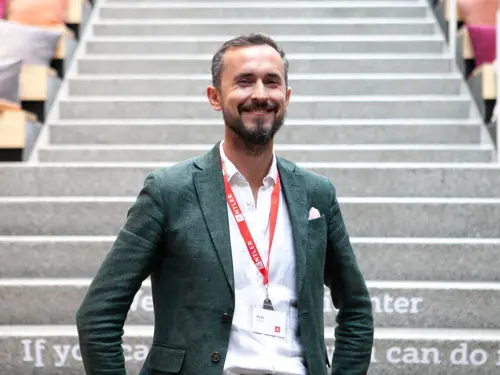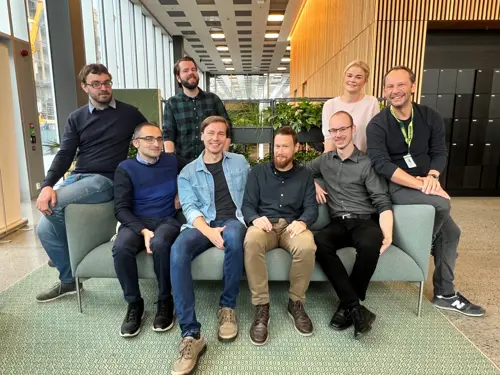
SURPRISED: Ensieh Khasheh was pleasantly surprised to learn about the flat organizational structure we have in Norway. Photo: Sondre Tallaksrud
– Seeing people put their feet up on the desk in front of their boss was a huge culture shock
Can Norway learn anything from Iranian work culture?
After coming to Norway in 2011, Ensieh Khasheh works as an automation engineer for ABB, where she deals with vessels that sail all over the world.
When she started this job, she was surprised at how short a distance there is between employee and boss in Norway.
– There’s a friendlier work culture in Iran
– It’s respectful and friendly, but not at all as formal as other places – not a lot of hierarchy. For instance, you can have a cup of coffee with your boss, she says.
In comparison with other countries, Ensieh’s noticed that in Norway, you can leave work before your boss with no problem.
– It was also a bit of a culture shock to see that if they want, employees can put their legs up on the desk or chewing tobacco in their mouth right in front of their boss. The employee doesn’t have to hide anything and can in many ways just be ‘who they wanna be’ at work.
– Is there anything Norway can learn from Iranian working life?
– The work culture’s friendlier in Iran. Colleagues are closer to one another and have tighter relationships than is generally the case in Norway, she says.
– Do you think that we have boundaries between our work and private lives in Norway?
– Yes, absolutely, there are boundaries here. In Iran people try to get together a lot more often for simple reasons. It might be that somebody’s just had a baby, or a co-worker’s bought a new apartment, or somebody has a birthday. It doesn’t have to be a milestone birthday, either; you celebrate it with your colleagues by having birthday cake no matter what.
Ensieh heard about Tekna when she was a student; after she became a member, Tekna helped her find out how to apply for jobs in Norway, including what her CV should look like and how to write an effective cover letter.
– This all helped me a lot. We don’t have these kinds of trade unions in Iran, so this was a totally new experience for me, she explains.
– Do you have any tips for people who’re working in Norway and want to increase their network here?
– Generally speaking, it’s not easy to create a network and find friends in Norway, but it’s not impossible, either. It’s a lot easier if you learn the language. Learn as much as you can about Norwegian culture by joining organized hikes and things like that. You’ll find that there are a lot of different activities in Tekna, she says.
Listen to more about Ensieh Khasheh’s experience of Norwegian working life here:
We have a right to speak up about working conditions
Tekna advisor Alexander Iversen agrees with Ensieh Khasheh that the distance between employee and boss is shorter in the Norwegian workplace than in many other countries.
– In most cases you don’t have to go far to get in touch with a company’s top-level management.
He explains that there’s a flatter organizational structure in Norway compared with other Western countries like England and France.
– There are three main pillars of The Norwegian Model
– There’s more of hierarchy in England and France, and their trade unions aren’t as strong, either. While they do have a few strong unions, they’re not as widespread as in Norway, and they also play a slightly different role in society. For instance, they’re not as involved in company operations as here in Norway, where employees have a say about how things run.

– As employees, we have the right to influence our working conditions through our trade unions. This applies to all organizations that have a collective bargaining agreement, including organizations that don’t have this kind of agreement, instead following the regulations found in the Working Environment Act. But these rights are stronger when you have an agreement that’s been negotiated through trade unions, he explains.
The Norwegian Model
If you work in Norway for any length of time, you’ll probably hear about "The Norwegian Model".
– There are three main pillars of The Norwegian Model. They are high-quality public services, sound financial management and a high level of trade union organization, explains Iversen.
Public services include things like free education, subsidized daycare, free healthcare services, government pension plans along with other plans ensuring that everyone will have a minimum of the services they need to get along well in life.
There’s also sound financial management that includes statistical models on which everyone agrees. In Norway we use something called the “Big 4 Model”.
– Industries that compete with foreign companies negotiate first. They find out how much we can raise wages that year and remain competitive. And the amount they come up with becomes the norm for everyone else. At the same time, this isn’t a universal wage ceiling, as there might also be different local wage levels in companies that belong to a particular sector.
The third and last point in The Norwegian Model is trade union organization. Simply put, you’re not seen as a ‘rebel’ if you become a member of a trade union in this country.
– It isn’t just charity
It’s common for people to belong to a trade union in Norway. But this didn’t just happen; on the contrary, workers have been fighting for this right for a long time.
– A well-known episode in Norwegian history is the match workers’ strike in Kristiania [Oslo] in the 1880s, which started after a group of female workers suddenly had their wages cut for no reason. These women reacted by banding together and going out on strike, fighting for higher wages and less dangerous working conditions. These were the two points the strikers wanted to win the most because they were working with dangerous chemicals and getting poisoned on the job.
– They weren’t the first trade union in Norway. They weren’t even the first strikers here, but they were enormously inspiring because what they did was so popular. They had such a great amount of public support that they became a huge inspiration for other workers, says Iversen.
He explains that it’s important to know that the comprehensive public services and social safety net we have in Norway isn’t free.
– It isn’t just a desire to be charitable that makes the government pay for our public services. Somebody’s fought for all the benefits you enjoy – your pension, your extra vacation, etc. First, trade unions have negotiated them; secondly, the government has decided to pay for them – it doesn’t do it just to be nice.
– Subsidized kindergartens make it easier for Norwegian women to work outside the home. Free education makes sure that people from low-income families have the opportunity to develop and more easily use their talents. So a well-developed Norwegian ‘welfare state’ is also an investment in creating more productive employees who contribute to the Norwegian economy, concludes Iversen.



